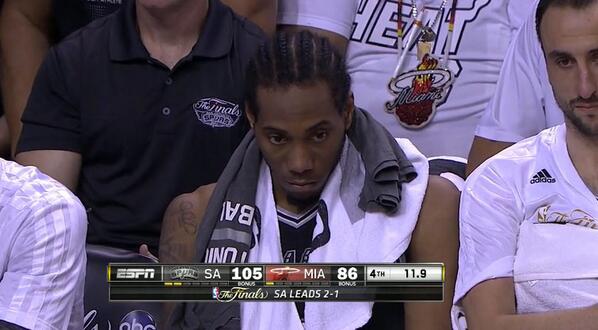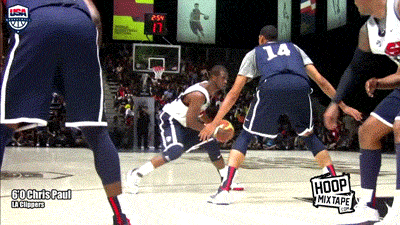Is Shabazz Muhammad overrated?
What the scouts and stats are saying about the top NBA draft prospects
Updated: March 29, 2013, 3:37 PM ET
By Kevin Pelton | ESPN Insider
What do the stats have to say about Shabazz Muhammad's game?
Last week's drama involving UCLA star Shabazz Muhammad made clear what statistical analysts have long known about the NBA draft: Age matters. The Bruins have been listing Muhammad's birthday as Nov. 22, 1993, but an investigation by the Los Angeles Times found that Muhammad's birth certificate is actually dated a year earlier, making Muhammad 20, and not 19 -- older than the typical college freshman. If Muhammad declares for the NBA draft as expected, the difference could cost him a few spots in the lottery. It should.
While Muhammad's unusual case is an extreme example, history shows that age is key to understanding how college players end up developing in the NBA. In fact, age is one of just two factors that make up my rankings of college players. The other is their performance during the previous season, translated to its NBA equivalent based on the past performance of rookies and adjusted for strength of schedule.
The rookie translations generally do a good job of separating newcomers who are ready to contribute right away from those who are too raw to contribute. But in terms of projecting value beyond the first season, as measured by wins above replacement (WARP) in the players' first five years in the NBA, age proves almost equally important. Based on regression, age makes up about 40 percent of the WARP projection for rookies, with translated performance accounting for the other 60 percent.
That's bad news for Muhammad. First off, his NBA translation is poor, pegging him for a .313 winning percentage -- far worse than replacement level (.410) -- due to his low numbers in assists, steals and blocks. Because players develop so quickly in their teens and early 20s, such a projection isn't a death knell for a freshman. Eric Bledsoe, for example, rated similarly playing out of position at Kentucky.
That's where Muhammad's age is problematic. Because age, not class, predicts future development, we're now effectively comparing Muhammad to more polished sophomores. The extra year takes a significant chunk out of his WARP projection, dropping it from 1.0 WARP per season to 0.4 -- a figure that usually lands a prospect in the second round. My database, which includes all college rookies since 2005 and selects ones dating to 2000 (based on the availability of team stats), has just a handful of lottery picks with a WARP projection of 0.5 or lower.
Player Year Pick pWARP
Joe Alexander 2008 8 0.5
Acie Law 2007 11 0.5
Melvin Ely 2002 12 0.3
Brandon Rush 2008 13 0.3
Terrence Ross 2012 8 0.2
Leaving out Terrence Ross, who is still developing, none of the other players became regular starters, and Joe Alexander is one of the biggest busts in recent draft memory. Muhammad isn't necessarily consigned to the same status -- he profiles as similar to Golden State's Harrison Barnes, who narrowly escaped this list (0.6 projected WARP) and has started for a playoff-bound team as a rookie. Still, Muhammad's combination of age and underwhelming performance at UCLA should give teams drafting in the lottery major cause for concern.
Muhammad isn't the only player on whom the numbers disagree with conventional wisdom. Let's take a look at five favorites of the stats, five players the scouts prefer and five lottery picks on whom they agree.
STATS SAY ...
Kyle Anderson, F, UCLA
Big Board rank: 42 | 1.9 projected wins above replacement (WARP)
(Rank: 11)
Why the stats like him: Anderson used his size and wingspan to rack up 62 steals and 30 blocks as a freshman. Usually, that combination of skills suggests a quality NBA defender.
Why scouts are skeptical: Anderson's nickname is "Slow Mo," and it's apt. Despite his length, Anderson will be hard-pressed to defend NBA perimeter players, and he can be outmuscled by big men.
Kentavious Caldwell-Pope, SG, Georgia
Big board rank: 31 | 2.2 projected WARP (7)
Why the stats like him: Caldwell-Pope shouldered a heavy offensive load at Georgia with reasonable efficiency. Young for a sophomore -- he's three months younger than Muhammad -- Caldwell-Pope has room to develop.
Why scouts are skeptical: As Caldwell-Pope's jumper goes, so goes his overall performance. As a result, he made better than 40 percent of his shots just three times in his last 10 games.
Sam Dekker, SF, Wisconsin
Big board rank: 76 | 2.6 projected WARP (4)
Why the stats like him: Coming off the bench, Dekker made 57.1 percent of his 2-point shots and 39.1 percent from beyond the arc. Ken Pomeroy's similarity scores say the best match for his freshman campaign is lottery pick Ben McLemore.
Why scouts are skeptical: Dekker is seen as a better college player than a pro. Before he can even think about the NBA, he'll have to crack Bo Ryan's starting five first.
P.J. Hairston, G/F, North Carolina
Big board rank: 37 | 2.4 projected WARP (6)
Why the stats like him: After moving to power forward as part of North Carolina's small-ball starting five, Hairston emerged as an elite scorer. Among players who used at least a quarter of their team's plays, Hairston ranked in the nation's top 10 in offensive rating.
Why scouts are skeptical: Playing on the wing as a pro, Hairston will have to improve his ballhandling. Part of the reason he was so efficient is that he rarely tries to make plays for others.
Jarnell Stokes, F/C, Tennessee
Big board rank: 96 | 1.9 projected WARP (13)
Why the stats like him: Stokes' size and strength make him an elite offensive rebounder, a skill that tends to translate nicely to the NBA. He's also a fine shot-blocker and played half of this season at age 18 after graduating early from high school.
Why scouts are skeptical: Stokes isn't a particularly accurate finisher around the rim, in large part because shot-blockers give him difficulty.
SCOUTS SAY ...
Archie Goodwin, SG, Kentucky
Big board rank: 21 | 0.6 projected WARP (50)
Why the stats don't like him: Among a group of Kentucky freshmen who collectively failed to live up to the hype, Goodwin stands out. He's not yet ready to score efficiently in the NBA and projects to make just 22.4 percent of his 3-pointers.
Why scouts do: There's no denying Goodwin's ability to put points on the board, and part of his struggles as a freshman can be traced to spending time running John Calipari's offense as a point guard -- something he won't be asked to do as a pro.
Alex Len, C, Maryland
Big board rank: 11 | 1.0 projected WARP (33)
Why the stats don't like him: Len is still very much a project and could be overmatched against NBA competition next season. He's weak on the glass for a 7-footer and hasn't yet polished the skills to overcome that deficiency.
Why scouts do: Skilled 7-footers are a commodity, and the Ukrainian is young enough to make strides quickly as a pro.
Ben McLemore, SG, Kansas
Big board rank: 2 | 1.7 projected WARP (19)
Why the stats don't like him: As a scorer, McLemore should be just fine in the NBA. The numbers don't suggest he'll develop the all-around game to justify a top-five selection, and he's already 20.
Why scouts do: McLemore's combination of size and skill are hard to find outside the lottery. If he can be convinced to play more aggressively on offense, he could be an elite scorer.
Shabazz Muhammad, SF, UCLA
Big board rank: 7 | 0.4 projected WARP (53)
Why the stats don't like him: The biggest Muhammad red flag is his poor steal rate. Besides their intrinsic value, steals are especially important for prospects because they are the best single statistical indicator of athleticism. The only perimeter player in recent history to develop into a full-time starter with so few steals is another UCLA product, Arron Afflalo of the Orlando Magic.
Why scouts do: Muhammad's powerful frame will allow him to post up smaller defenders and gives him the potential to become a strong one-on-one defender.
Mason Plumlee, PF, Duke
Big board rank: 14 | 0.3 projected WARP (56)
Why the stats don't like him: At 23, Plumlee needs to be ready to contribute right away to justify a spot in the lottery, but his translated numbers score right near replacement level. He lacks a signature statistical skill.
Why scouts do: Plumlee boasts the requisite size and athleticism for an NBA big man, and he started the season as one of the best players in the country through December.
BOTH AGREE ON ...
Nerlens Noel, C, Kentucky
Big board rank: 1 | 4.0 projected WARP (1)
What both like: Before his ACL injury, Noel scored far and away as the best prospect in this draft. The difference between his WARP projection and the No. 2 prospect (Georgetown's Otto Porter) is as large as the gap between Porter and No. 7.
Victor Oladipo, SG, Indiana
Big board rank: 6 | 2.0 projected WARP (9)
What both like: Oladipo's athleticism shows up all over his statistics, nowhere more than at the defensive end. Only one other player in my database (Renaldo Balkman) had a combination of a steal rate better than 3.0 and a block rate better than 1.5. And Oladipo is a much better offensive prospect than Balkman, the infamous Isiah Thomas selection taken one pick ahead of Rajon Rondo.
Otto Porter, SF, Georgetown
Big board rank: 4 | 3.1 projected WARP (2)
What both like: Porter's all-around game will ease his transition to the NCAA. Compared to other small forwards in my database, Porter is among the top 25 percent in six key categories and does not have a single statistical weakness (among the bottom 25 percent). Plus Porter is nearly seven months younger than Muhammad.
Marcus Smart, PG, Oklahoma State
Big board rank: 3 | 2.5 projected WARP (5)
What both like: Rebounding is a surprisingly important indicator for point guards because it demonstrates the athleticism to excel at the position. Smart is great on the glass and has the best steal rate of anyone in this year's draft, another positive marker.
Cody Zeller, PF, Indiana
Big board rank: 8 | 2.1 projected WARP (8)
What both like: Besides Noel, Zeller is the other top-10 player who lands in the same spot in both rankings. His polished game has just one statistical weakness: shot-blocking.




















